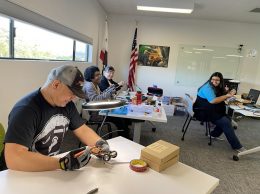Distiller bets on enthusiasm for Central Coast craft liquor
Central Coast flavors in all stages of distillation deliver a powerful aroma of sugar, wine and spices just one step inside the door of Calwise Spirits.
In the back room, founder Aaron Bergh tweaked the flow of the still, cooling down the “tail” cut of a batch of rum — what’s left after he’s extracted the higher-quality alcohol that will get bottled into Calwise’s products.
Making those cuts is “where the skill in distillation and subjectivity and creativity come into play,” Bergh said.
A graduate of the Cal Poly San Luis Obispo Hothouse incubator program, the distillery and tasting room is betting the same enthusiasm that put the region at the heart of the craft wine and beer movement is headed for spirits next.
“People discovered that alcohol can be better and now they demand – not even demand, they expect high quality, tasty, complex, sophisticated beverages,” he said. “Spirits are the last thing to undergo that renaissance.”
The growth has included the launch of a line of liqueurs, with simple craft cocktail recipes to introduce new users to the world of craft spirits, and the company’s first whiskey release Nov. 22.
Since leaving the HotHouse, Calwise has swelled to fill a 6,000-square-foot location in Paso Robles, where it produces around 2,000 cases annually. As it looks to grow its team, its six employees include Bergh and an assistant distiller, marketing coordinator and three bartenders for the tasting room.
The site was a dirt lot on Craigslist when he ran across it, Bergh said. Just a mile down the street from the headquarters of internationally recognized craft brewer Firestone Walker, the landlord hoped to fill it with innovative beverage companies.
“Having our own distillery here has really allowed us to branch out, experiment and discover new flavors,” Bergh said, starting with an orange liqueur, which is among the most common ingredients in cocktails.
Spirits can be an intimidating market for casual fans of craft beer or wine, he said. While they can be tasted straight, most customers prefer a cocktail. In creating the recipes to sample its products, the team kept that in mind, limiting themselves to simple ingredients.
“We wanted people to feel comfortable taking our bottles home and knowing and feeling empowered that they could make a cocktail,” he said. The site “serves as a kind of showcase of what you can do with our spirits, to give people inspiration.”
Like its flagship rum and gin products, which use ingredients like Central Coast cabernet sauvignon grapes and native herbs like juniper, chamomile, lavender and sage, the new products incorporate flavors from the nearby agriculture community. That includes fresh, local oranges from a neighboring farmer.
“We’re all about using local ingredients as much as possible, wanting to support local businesses. But too, we’re about crafting spirits that are truly an expression of the Central Coast of California,” Bergh said. “If you think about it, all the most interesting distilleries and expressions of spirits out there are heavily influenced by the environment where they’re produced.”
A year into the move, its core Big Sur Gin is still its No. 1 seller. Despite the industrial feel to the complex and copper accents throughout the tasting room, Bergh said he wanted to bring natural touches to the decor to reflect the places the ingredients are found.
The company works with a distributor to get its products to Whole Foods, BevMo, Total Wine, Albertsons and Vons stores on the Central Coast and throughout Southern California. From there, Bergh said the company plans to continue to expand throughout the state.
As rules against home production were lifted, craft spirits took off, and the removal of restrictions on sales at distilleries and tasting rooms have further helped spirits makers pencil out.
“These renaissances have come about because of the lifting of constrictive regulations on alcohol, going back to the Prohibition,” he said.
But bans on shipping directly to consumers have limited how much it can expand its members club, which has grown to some 170 customers.
The sunsetting of a federal excise tax exemption by the end of the year also poses a threat to the spirits industry, particularly newer producers, said Margie Lehrman, CEO of the American Craft Spirits Association.
The industry’s growth can be traced back beyond craft beer and wine, to the farm-to-table movement, Lehrman said.
“We see that as a trend that’s here to stay,” she said. “There are very, very clear relationships between our distillers and our farmers.”
Tasting rooms and cocktail bars that have sprung up are a “massive investment” for a distiller, she said, that help drive R&D within the industry and connect brands with a loyal customer base.
Around half of Calwise’s sales come from local customers, he said, while the other half come from tourists that visit from the Central Valley, Bakersfield, Southern California and elsewhere.
As the company grows, it looks to neighboring Firestone Walker and other beverage companies in Paso Robles’ Tin City area, with whom it trades barrels and sources products like grapes to bring new flavors to its products.
“It’s kind of a roadmap for us distillers on what to do next and how to grow our industry,” Bergh said.
• Contact Marissa Nall at [email protected].












